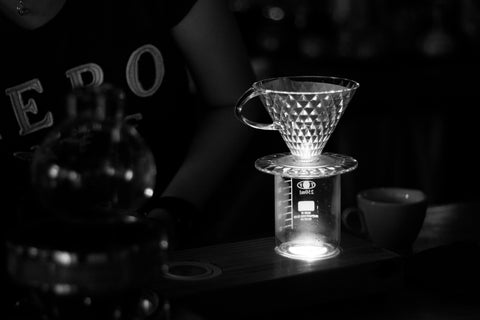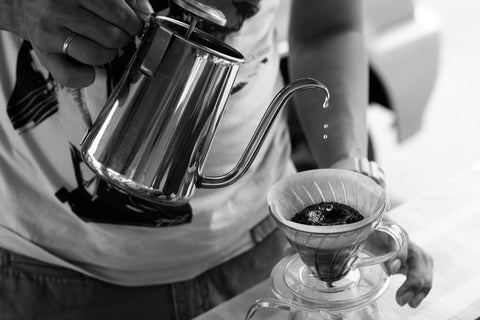Free Shipping above RM80 & all subscriptions
Free Shipping above RM80 & all subscriptions
Add description, images, menus and links to your mega menu
A column with no settings can be used as a spacer
Link to your collections, sales and even external links
Add up to five columns
Add description, images, menus and links to your mega menu
A column with no settings can be used as a spacer
Link to your collections, sales and even external links
Add up to five columns
Two Important Variables in Coffee Brewing

Grind size matters!
We talked about how much of coffee beans for a cup of coffee in previous post. Now let's get to next most important aspect about coffee brewing - the extraction!
Like the previous one, this post is dedicated to filter coffee brewing rather than to espresso. For espresso, click here.
Coffee brewing is no rocket science.
Matt Perger has written many eye-opening topics for coffee professionals in Barista Hustle, one of our favourite coffee blogs!
He wrote about the basic of extraction theory, including the very detail of how time and grind size (surface area) will affect extraction, and also how over- and under-extraction taste like.
If you are really into coffee, we highly recommend you to read it up, start brewing and taste lots of coffee. The objective is to get yourself familiarise with each characteristic of under- and over- extraction.
But for an average tongue of a home brewer, we really think it's a little too deep to understand, especially on the extraction tasting part!

Extract all the goodness in coffee.
What is Extraction?
To understand “extraction”, we take an example of a sugar cube.
Put a sugar cube into water, it will fully dissolve with water in the end.
However, to fully dissolve a sugar cube, it depends on how long the cube is in contact with water, how much the surface area (crushed or whole cube), high or low of water temperature and amount of agitation (stirring) until it's fully dissolve.
Same to coffee, about 30% of coffee bean is soluble with water. The tricky part is that, not all of 30% solubles taste good.
Imagine if you boil finely ground coffee over stove for 10 minutes, you might probably extract all solubles, but result in an awfully bitter, woody and lifeless cup of black liquid.
This then lead to the infamous mythical question, how much to extract from the coffee beans?

Drip by drip, for better coffee extraction!
How to taste extraction?
There are a whole bunch of articles and information about this topic, try google 'coffee extraction', Wikipedia will give you a formula of coffee extraction, VST gives you a refractometer, and Barista Hustle stays on top of the page.
For a home brewer, the number doesn't matter to you. All you need is to know how to taste your coffee with your tongue!
To taste extraction, one of the easiest way is to concentrate on the taste (sour/sweet/bitter) of aftertaste!
When you sip your coffee, an under-extracted coffee tastes sour, while over-extracted coffee has a bitter lingering aftertaste.
A super over-extracted coffee will give you the worst day of your life, the bitterness will stick on your tongue, dry your throat and you'll be drinking water for the next one hour.

What on earth does hollow or transparent taste like?
The ultimate goal, a sweet cup of coffee!
The aim is to brew a sweeeeet cup of coffee, delightful mouthfeel, pleasant and ever lasting aftertaste. To get there we need to get the right grind size and brew time, with your perfect brew ratio!
As mentioned earlier, how much to extract depends very much on these few variables,
Grind size, brew time, water temperature and agitation
We suggest to fix the water temperature (roughly 93˚C) and brewing style (agitation) to avoid any brewing inconsistency. You want to know exactly what went right or wrong in each brew.
To make it simple, just leave the variables to grind size and brew time only!
To reach our aim (sweet coffee!), very often that we need to trial and error first!
Let's say we have a new bag of Ethiopia Yirgacheffe Kongo, let's try and start with a default recipe first! I personally like the ratio of 7g of coffee to every 100g of water, my favourite morning coffee brew ratio!
First try
21g of coffee : 300g of water
Brew time 2.30 minutes
Medium fine grind size (setting on 4)
Taste - Hmm.. not very acidic and has a decent level of sweetness, but aftertaste is quite bitter.
*It's a little over extracted on the first try. To adjust, start with changing the grind size first!
Second try (fixed all variables other than grind size!)
21g of coffee : 300g of water
Brew time 2.30 minutes
Medium grind size (slightly coarser than first try - setting on 4.5)
Taste - Not bitter this time, it's a sweeeeeet cup of coffee and long finish.
The reason to adjust on grind size first is because a click on grinder setting gives much significant changes to extraction as compared to brew time.
Sometimes the best extraction falls annoyingly in between of grinder settings (4.25???) where it's impossible to tune in, hence we shall either prolong (extract more) or shorten (extract less) brew time, best with difference of 20 seconds or more!
COFFEE IS GOD!
Different roast level of coffee
Simple theory, darker roast coffee is easier to extract than lighter roast coffee.
Take an example of Malaysia Liberica Dark Roast. Dark roast coffee is much soluble and easy to extract. Hence a coarse grind size, short brew time (1.30 mins) and lower water temperature (85ºC) will be sufficient to extract the goodness of coffee.
However for light roast coffee, the beans itself is not as soluble and much difficult to extract it's flavours. To encourage extraction, a finer grind size, longer brew time (2-2.30 mins) and higher water temperature (95ºC) is preferred.
Especially for high altitude coffee (2000m above sea level) like Panama Gesha, which usually lightly roasted. The coffee bean is so dense that it required boiling water to extract. And most of the time, its pretty difficult to over extract too!
Find the Perfect Coffee that you'll love
Most importantly, you'll have to select the right coffee that suits to your preference.
Every coffee is different and has their very own unique characteristics. Coffees like Brazilian or Indonesian coffee are usually bold and pungent, whereas most African coffees are lighter in body but extremely flavourful with bursting fruity floral notes!
To make it easy to select your very own coffee, we have a series of questions that makes selecting your very own Perfect Coffee easier than ever. We break down all the coffees into brew methods and your preferred strength of coffee.
If you have specific preference like you prefer fruity coffee, click on Sidebar Tags and look 'Fruity'. You'll find all fruity coffees that we have in store!
Coffee brewing is indeed very interesting yet challenging. Different coffees extracts differently, and very often we screw up our first cup of coffee too.
Always try with new coffees, understand the simply theory of extraction, after which you will get to enjoy a very rewarding sweet and delicious cup of coffee everyday. Coffee brewing is not rocket science after all!
While writing this, Matt Perger came out with an amazing Coffee Compass for filter coffee brewing too. Why have we never thought of making diagrams for coffee recipe?
Happy brewing!
Also in Coffee Blog
How to Store Your Coffee Beans
Storing your coffee beans is probably the most important aspect to ensure you get to enjoy delicious cup of coffee everyday. A proper beans storage will best preserve the beautiful aromatics of coffee for a long long time. Here's how.
Read More
Subscribe
Sign up to get the latest on sales, new releases and more …
We clean up after ourselves.
Ecommerce deliveries have a carbon footprint. That's why we support verified projects that remove carbon from the air.
PARTICIPATING BRANDS AND CUSTOMERS HAVE HELPED FUND
72+
million
Carbon-neutral orders
51+
thousand
Tonnes of carbon removed
THAT'S LIKE...



6
billion
Smartphones charged

211
million
Kilometers driven by a gasoline-powered car
HOW IT WORKS


Every delivery’s carbon footprint is calculated based on weight, shipping method, and distance traveled. We neutralize these emissions by purchasing verified carbon removal credits from groundbreaking projects. When you add a contribution to your order, 100% of that money is used to pay for additional carbon removal.


MAKING A DIFFERENCE


With your purchase, you’ll join a community of proactive merchants and customers dedicated to a sustainable future. Together, we've removed emissions for over 72 million deliveries and removed over 51 thousand tonnes of carbon.
FUTURE-PROOFING OUR PLANET


We work with a network of pioneering carbon removal companies that have been vetted by the commerce platform Shopify.

Carbon-neutral shipping on all orders
3336kg
shipping emissions removed
That's like...
8540
miles driven by an average gasoline-powered car

We're Spilling the Beans...
Get an early look at new coffees, updates, and promotions on your favourite beans. Subscribe & get free shipping on your first order!


